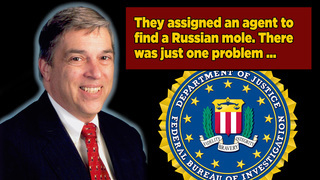5 FBI Screw-Ups (They'd Really Like Everybody To Forget)

Despite many T-shirts boasting that their wearers are Female Body Inspectors, the actual FBI is an intelligence agency. But the people there are somewhat similar to the wearers of those T-shirts, in that they experience spectacular failures. Like how ...
The FBI Never Managed To Solve A Dumbass Burglary Into Their Own Office
Some of the shadiest stuff the FBI has ever done fell under a project called COINTELPRO. The feds cracked down a bunch of activist groups by surveilling them illegally, infiltrating them, fighting them with propaganda, and occasionally working to arrange their deaths. We don't know about COINTELPRO because a whistleblower spoke up or because after few years passed, the FBI finally shrugged and said, "Let's release this info. It's time to come clean." We know about it because a set of burglars broke into their office and stole a thousand documents.
The gang called themselves the Citizens' Commission to Investigate the FBI -- unlike vaguely named groups like "Americans for Freedom" or whatever, these guys weren't screwing around when it came to defining their purpose. They'd had some success at pulling off smooth burglaries in the past. In 1970, they wanted to break into the local draft office and steal their selective service records. One of them just stuck a note on the door reading: "Please don't lock this door tonight." That night, sure enough, the door was unlocked, and they were able to slip right in.
The following year was when they planned the break-in on the FBI's office in Media, Pennsylvania. Their strategy? They timed the burglary for the night Muhammad Ali was going to box Joe Frazier.

via Wiki Commons
They figured that even if they made noise, no one near the office would pay attention because they'd all be glued to their screens. They were right. One burglar, Keith Forsyth, came prepared with the skills and picks to crack open the door's lock, but when a new lock proved too stubborn, a crowbar did the trick. Then the gang went in, looted the place of documents, and went on to release to the Washington Post the ones they figured Americans had the right to see.
Even if their cause was just, the gang broke the law and so faced criminal charges if the FBI could identify them. But the FBI could not. This despite correctly guessing that one of the culprits had to be that strange young woman who'd entered the office recently, claiming to be a student reporter writing about jobs for women. The woman was actually Commission member Bonnie Raines casing the joint. They'd neglected to get her name before letting her tour the place, and she'd carefully kept her gloves on to avoid leaving prints.

The FBI never solved the case. Which prompts the question, geez, if you agents can't even solve a break-in into your own office, how are we counting on you to solve anything else? You might have another question too: How do we know the names "Bonnie Raines" and "Keith Forsyth" if the FBI never tracked the culprits down? Well, the Commission members came forward and identified themselves ... once they could no longer be charged. Sorry, FBI, statutes of limitations are a bitch.
FBI Agents At A Rescue Took Orders From An Army Man (Who Was Really A Fraudster There To Steal)
Interstate 40 passes over the Arkansas River in Oklahoma, thanks to that wondrous technology known as a "bridge." But on May 26, 2002, the interstate very much failed to pass over the river, thanks to a wondrous phenomenon known as a "bridge catastrophically collapsing."
Over in the river was a tugboat dragging two barges. Piloting the boat was a man with the darkly prophetic name of Joe Dedmon. On that day, Captain Dedmon passed out thanks to a heart episode. His huge barges crashed into the pier beneath the bridge, which tore down the supports holding the bridge, which dumped the bridge into the water.

Fourteen people died during the disaster. The FBI was soon on hand to handle rescue efforts along with other responders, and they immediately found themselves ordered around by the man in charge. He was William James Clark, who wore military fatigues and called himself a captain in the U.S. Army. Whether it was normal for the army to send a captain over to oversee such matters was not a question that occurred to any of the FBI to ask. In fact, Clark was not a captain and had previously been arrested multiple times for impersonating one.
Now, if this was just some guy who donned a costume to take control and help everyone out, that might make him a superhero. A criminal, who the FBI should have caught on to, but a superhero all the same. But it looks like Clark had a little more on his mind than just assistance. For starters, he stopped over in the Army surplus store, picked up $400 in free goods and left, falsely saying the government would pay for it. Then he racked up $900 in hotel bills, again saying the government would pick up the tab. Then he borrowed a pickup truck, saying he needed it for the rescue effort, and just drove away in it. Figuring it was only a matter of time till his charade collapsed like a rickety interstate bridge, Clark fled to Canada, where he was caught by a group far more competent than the FBI: the Canadian Mounties.
Despite the FBI's inability to spot what Clark was doing at the time, prosecutors eventually charged him, and he got 70 months. But that wasn't the end of Clark's adventures as a maybe-military man. In 2007, he phoned the Russian embassy. The US military was planning to assassinate Vladimir Putin in the coming days, he said, and he William James Clark was part of the team that would do it! The FBI investigated and found that while Clark admitted lying about being a part of the team, he had at some point really been convinced about the plot, having peered through a vent and spied on his coworkers seemingly discussing it. Clark was mentally ill, you see. Which explains why those FBI agents so easily mistook him for a superior.
They Butt-Dialed A Serial Killer, Tipping Him Off And Setting Him Free
Michael McGowan worked undercover for the FBI for 30 years. When he finally retired and could talk about his years in the trenches, he was able to share all kinds of stories of exciting agent shenanigans. Like the time he posed as a gangster named El Viejo and met Mexican drug lord El Chapo's gang to arrange a cocaine sting. Or his years pretending to be a Boston mobster named Irish Mike. Or his going undercover as "The Walrus," a title that was a reference to his mustache. (Note: 90 percent of FBI resources go into thinking of cool nicknames.)
But we aren't here to gush about how cool it is for FBI agents to play dress-up. We're here to give FBI agents a dressing down, and McGowan's bio also comes with candor about various screw-ups. He talks of how, early in his career, he was sent into a mob meeting with hardly any training and was immediately thrown out. And you know how TV would have us believe detectives conduct interviews at strip clubs at least once every week? McGowan did go to a strip club on business at least once, with a fugitive's photo in his pocket. He left his coat behind as he got up from his seat, and when he returned, the photo had vanished from the coat and everyone was staring at him. He made no progress at getting closer to the fugitive that night.

The biggest disaster he shares happened around 2009. His team's brushes with criminals had put them in touch with someone they suspected might be a serial killer. They seemingly didn't have enough to start an official investigation, much less charge him with anything, but they stayed in contact with him, while claiming to be criminals themselves. Soon after talking to him on the phone one time, the team sat down and talked out what sort of approach they should next take. (We've included this video of him describing it just so you can see why they called him The Walrus.)
Then one of the agents realized he'd just pocket dialed the guy they were talking about. The killer had heard their whole conversation. That was the last time they managed to managed to speak with him, though he did leave them one last message telling them to stay away. "He's still on the street," says McGowan. "He's behind you in the grocery store." He might even be sitting in your chair right now.
They Spent Two Years Investigating An Anti-Goth Cult (Which Was Just A Satirical Website)
The FBI keeps tabs on extremist groups online, because someone's got to be ready to respond the moment idle complaining gives way to gunning down your opponents. And in 2005, their attention turned to a posting on a Yahoo group called "Parents Against Goths," which linked to another group called GodHatesGoths. The name seemed to play on a famous anti-gay slogan and URL used by the Westboro Baptist Church, and this group seemed to go further than Fred Phelps and his family, claiming it was their mission to "kill homosexuals." That wasn't their only target, though. They also wanted to kill fortune tellers, nonbelievers, and "women who are not virgins on their wedding nights," among others.

Their biggest target, of course, appeared to be goths, and the FBI got much of their info on the group from a goth who was in contact with them (i.e., a rando who also stumbled on a thread and argued back and forth with the poster). The group formally called themselves The Church of the Hammer, it seemed, a reference to a 15th-century book about fighting witchcraft. Witchcraft doesn't really exist, but that doesn't make those who want to kill witches any less dangerous.
One Reverend Randy Green was said to lead the group. Green's followers had been caught for arson in Colorado and next came to Massachusetts, where Green was arrested and jailed briefly for assault. At least, that's what the internet said. The FBI tried looking into police records to find more information about this but were unable to. Strange. Maybe Green used multiple names. They had to find out for sure because this could be a cult with murder on their minds.
Agents spent two and a half years investigating the group. Well, presumably, no one in the FBI was assigned to this case exclusively for the next two years, but that's how long the case lasted. Finally, it occurred to someone to read the entirety of the group's website. And they found there was no Reverend Green. There was no group. It was just satire. As indicated (if sections called "Nazi Goths" and "Vampire Goths" didn't give the game away) by text on the site, which read "This site is meant to be viewed as black humor, parody and satire on the very real people who DO think goth and metal is the devil's music."
More than a decade later, of course, the internet's a very different place. If someone tried creating a satirical anti-gay, anti-sex group today, it would immediately be overrun by people who share those beliefs unironically.
They Put A Mole In Charge Of Finding The Mole In The FBI
"Finding the mole" was just one of many roles Robert Hanssen held during over 20 years with the FBI. And throughout this time, he very much was a mole, secretly spying for the USSR and then Russia -- his tenure as a spy outlasted the nation he was spying for.

Unlike many spies recruited by intelligence agencies overseas, Hanssen made the first move himself, reaching out to the KGB in 1979. He'd heard about how the former anti-Soviet chief of MI6 turned out to be a Soviet spy, and while most people on his side of the Iron Curtain reacted to the news in horror, Hanssen thought, "That sounds cool. I want to do that." He made contact with the Soviets, letting them know about the FBI bugging them and revealing names of agents who secretly worked for America. Throughout this, he kept his own identity secret from the Soviets, to make sure no spies the FBI had over there could find out what he was doing.
Hanssen had started working for the FBI out of Indiana, but he now worked his way up to the New York office and then to D.C. As part of the Soviet analytical unit, he was tasked with finding who had been leaking agent names to the Soviets, and he somehow never produced this man's identity. He continued telling the Soviets about double agents though, and he let them know that the FBI had built an eavesdropping tunnel beneath their embassy. When the USSR collapsed, he took a little break, but he resumed communications via a new Russian contact, using his old Soviet codename.
He was finally caught in 2001, when most of us thought the Cold War was over. Over his decades as a mole, he passed along so much intelligence that once he was finally convicted, he was given life in prison without parole as part of his plea deal (otherwise, the death penalty for treason might have been on the table). It almost makes it seem like the whole thing wasn't worth getting paid $600,000 plus three diamonds.
Follow Ryan Menezes on Twitter for more stuff no one should see.